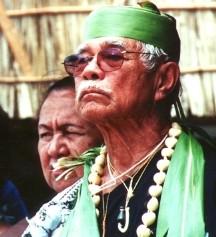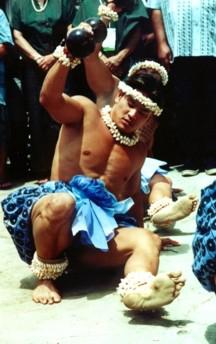Digital Collections
Celebrating the breadth and depth of Hawaiian knowledge. Amplifying Pacific voices of resiliency and hope. Recording the wisdom of past and present to help shape our future.
Kahikina de Silva
The haku mele of "Ka Ua Kanatī" identifies four events that defined the Hawai‘i delegation’s experience at the 8th Festival of Pacific Arts 2000 in New Caledonia: the traditional blessing of the hale Hawai‘i at the festival village in Noumea; the raising of the Hawaiian flag at a welcoming ceremony in the northern village of Poindimie; the arching of a rainbow across the crushed-coral dance-fields of remote Ponerihouen; and the waiting-out, in an old Army tent, of a downpour that accompanied the delegation’s final, festival-village performance. Each of the four events, in fact, was accompanied by rain: the rain at Nu‘umealani (the name of the hale Hawai‘i) that released the fragrance of the dancers’ ‘ōlena-dyed pā‘ū; the rain at Poindimie that spoke of the endurance of flag and people; the rain and rainbow at Ponerihouen that the kūpuna read immediately as a blessing for hilu-like behavior; and the rain that fell in waves at Noumea, wondrous rain that invigorated the kalo-linked children of the Pacific.
The mele bears a striking resemblance to those written in commemoration of Queen Emma’s 1871 expedition to the Kilohana Lookout of Wai‘ale‘ale, an event that forever linked its participants in a brother-sisterhood of "rain-drenched skin." The details of "Ka Ua Kanatī" are not those of the Kilohana chants, but "Ka Ua Kanatī"’s manner of extracting meaning from experience most definitely is. This mele says much for the continuity of the haku mele tradition—as do the seven others in this New Caledonia collection. Two chant collections, Kanak and Kilohana, are separated by more than a century and by several thousand miles of ocean; still, they speak the same language and originate in a clearly recognizable, shared na‘au.
Kaulana ē ka ua o ke Kanatī
Mai Noumea a i kai o Poneliwena
Ho‘opulu i ka ‘ili o ka malihini
Nolu pē i ka ninini wai a ka lani
E ala ke aloha i Nu‘umealani
‘O ka piko ‘a‘ala o ka lāhui
Kū maila ke ‘ala o ka laua‘e
A no‘ū ka ‘ōlena i ke kilihune
A Ponokemi au i ka ua loku
No ka welo ha‘aheo o ku‘u hae Hawai‘i
Nāna e ho‘omalu a e ho‘olōkahi
Ko‘o ho‘opa‘a kaupoku o ke ea
Pōnaha ke one o Poneliwena
I ka hele nihi a ka hilu no‘eno‘e
Ō mai ke ānuenue me kona nani kamaha‘o
E lala‘i maila i ka pae ‘ōpua
A he nani ē ke kili hau o Noumea
E po‘i ana i ka uhi o ka hale
He ua ho‘ōla i ka nohona Pākīpika
A ho‘oulu ho‘i i nā mamo a Hāloa
E ho‘i ke aloha i Hawai‘i kulāiwi
He aloha pili mau i ka ua loku
E pili mai ke ēwe i ka ‘iewe
I ola Hawai‘i i ka ‘ihi kapu
The fame of the Kanatī rain is known
From Noumea to the sea at Poneliwena.
It dampens the skin of its visitors
Until we are drenched in a heavenly downpour.
Love awakens at Nu‘umealani
Which has become a piko for our people
There, the fragrance of laua‘e is steady
And ‘ōlena becomes pungent under misty skies.
I have been to Ponokemi
For the proud raising of my own Hawaiian flag
This is the flag that protects and unites us
It raises and holds fast the sheltering roof of our sovereignty.
There are sand-circles at Poneliwena,
Made by the gentle movements of graceful hilu.
A rainbow responds, contributing its beauty
As it rests peacefully among ‘ōpua clouds.
The icy rain of Noumea is indeed a wondrous thing
As it breaks like waves on the hale.
It is a rain that invigorates the people of the Pacific
And inspires Hāloa’s children.
Love now returns to Hawai‘i, our kulāiwi,
But will keep us joined together, even in heavy rains.
The ēwe will always seek out the ‘iewe
And Hawai‘i will live on in high kapu.
© Kahikina de Silva, 2001

photo credit: Kīhei de Silva
‘Anakala Eddie Ka‘anana (shown with Māmā Kaleipua Pahulehua) presides over the blessing of Nu‘umealani, the hale Hawai‘i at the Festival Village in Noumea.

photo credit: Kīhei de Silva
Lance Takara of Ka Pā Hula Hawai‘i performs a "generative hula" on the muddy, rain-puddled walkway in front of the hale.